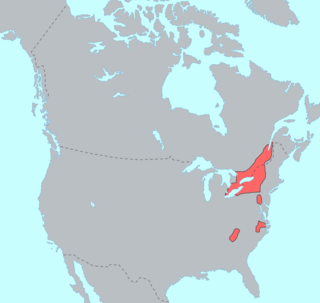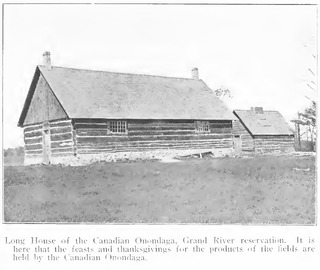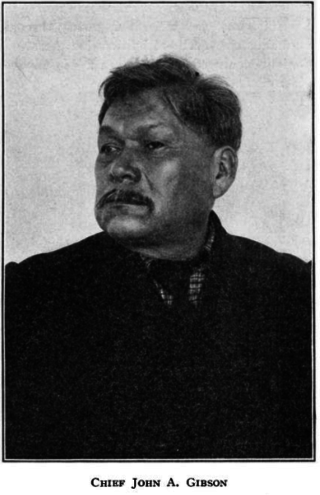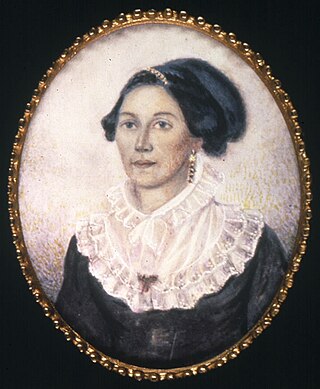
Hiawatha, also known as Ayenwatha or Aiionwatha, was a precolonial Native American leader and co-founder of the Iroquois Confederacy. He was a leader of the Onondaga people, the Mohawk people, or both. According to some accounts, he was born an Onondaga but adopted into the Mohawks.

Among the Haudenosaunee the Great Law of Peace, also known as Gayanashagowa, is the oral constitution of the Iroquois Confederacy. The law was written on wampum belts, conceived by Dekanawidah, known as the Great Peacemaker, and his spokesman Hiawatha. The original five member nations ratified this constitution near modern-day Victor, New York, with the sixth nation being added in 1722.

Thayendanegea or Joseph Brant was a Mohawk military and political leader, based in present-day New York, who was closely associated with Great Britain during and after the American Revolution. Perhaps the best known Native American of his generation, he met many of the most significant American and British people of the age, including both George Washington and King George III.

The Onondaga people are one of the five original nations of the Haudenosaunee (Iroquois) Confederacy in the Northeastern Woodlands. Their historical homelands are in and around present-day Onondaga County, New York, south of Lake Ontario.

The Iroquoian languages are a language family of indigenous peoples of North America. They are known for their general lack of labial consonants. The Iroquoian languages are polysynthetic and head-marking.
The Covenant Chain was a series of alliances and treaties developed during the seventeenth century, primarily between the Iroquois Confederacy (Haudenosaunee) and the British colonies of North America, with other Native American tribes added. First developed in the New York area at a time of violence and social instability for the colonies and Native Americans, the English and Iroquois councils and subsequent treaties were based on supporting peace and stability to preserve trade. They addressed issues of colonial settlement, and tried to suppress violence between the colonists and Indian tribes, as well as among the tribes, from New England to the Colony of Virginia.

The Treaty of Canandaigua, also known as the Pickering Treaty and the Calico Treaty, is a treaty signed after the American Revolutionary War between the Grand Council of the Six Nations and President George Washington representing the United States of America.
The Great Peacemaker, sometimes referred to as Deganawida or Tekanawí:ta was by tradition, along with Jigonhsasee and Hiawatha, the founder of the Haudenosaunee, commonly called the Iroquois Confederacy. This is a political and cultural union of six Iroquoian-speaking Native American tribes residing in the present-day state of New York, northern Pennsylvania, and the eastern portion of the province of Ontario, Canada.
William N. Fenton was an American scholar and writer known for his extensive studies of Iroquois history and culture. He started his studies of the Iroquois in the 1930s and published a number of significant works over the following decades. His final work was published in 2002. During his career, Fenton was director of the New York State Museum and a professor of anthropology at the State University of New York.

The Longhouse Religion is the popular name of the religious movement also known as The Code of Handsome Lake or Gaihwi:io, founded in 1799 by the Seneca prophet Handsome Lake (Sganyodaiyoˀ). This movement combines and reinterprets elements of traditional Iroquois religious beliefs with elements adopted from Christianity, primarily from the Quakers. Anthropologist Anthony F. C. Wallace reported that the Gaihwi:io had about 5,000 practicing members as of 1969. Originally the Gaihwi:io was known as the "new religion" in opposition to the prevailing animistic beliefs, but has since become known as the "old religion" in opposition to Christianity.

The Haudenosaunee, commonly known as Iroquois, are an Iroquoian-speaking confederacy of Native Americans and First Nations peoples in northeast North America and Upstate New York. They were known during the colonial years to the French as the Iroquois League, and later as the Iroquois Confederacy. The English called them the Five Nations, comprising the Mohawk, Oneida, Onondaga, Cayuga, and Seneca. After 1722, the Iroquoian-speaking Tuscarora from the southeast were accepted into the confederacy, which became known as the Six Nations.

Tadodaho was a Native American Hoyenah (sachem) of the Onondaga nation before the Deganawidah and Hiawatha formed the Iroquois League. According to oral tradition, he had extraordinary characteristics and was widely feared, but he was persuaded to support the confederacy of the Five Nations.

The Tree of Peace Society was founded in 1984 and incorporated in New York State on October 17, 1994, as a "foreign" not-for-profit corporation. Its headquarters are located on the Akwesasne Mohawk reservation in Hogansburg, New York, which borders the provinces of Quebec and Ontario, Canada, along the St. Lawrence River.

Jigonhsasee was an Iroquoian woman considered to be a co-founder, along with the Great Peacemaker and Hiawatha, of the Haudenosaunee (Iroquois) Confederacy sometime between AD 1142 and 1450; others place it closer to 1570–1600. Jigonhsasee became known as the Mother of Nations among the Iroquois.

John Arthur Gibson (1850–1912) was a chief of the Seneca nation of the North American Iroquois confederation. Part Onondagan and part Senecan, he resided within the reserve of the Six Nations of the Grand River in Ontario, Canada. Knowledgeable about Iroquois culture, he is best known for the versions he provided of the Iroquois oral constitution, the Great Law of Peace. He acted as an advisor to the Canadian Department of Indian Affairs in matters relating both to Iroquois and non-Iroquois indigenous people. He was a well-respected player of the traditional Iroquois sport of lacrosse until he was blinded during a game when he was 31.
A Dish With One Spoon, also known as One Dish One Spoon, is a law used by Indigenous peoples of the Americas since at least 1142 CE to describe an agreement for sharing hunting territory among two or more nations. People are all eating out of the single dish, that is, all hunting in the shared territory. One spoon signifies that all Peoples sharing the territory are expected to limit the game they take to leave enough for others, and for the continued abundance and viability of the hunting grounds into the future. Sometimes the Indigenous language word is rendered in English as bowl or kettle rather than dish. The Dish With One Spoon phrase is also used to denote the treaty or agreement itself. In particular, a treaty made between the Anishinaabe and Haudenosaunee nations at Montréal in 1701, as part of the Great Peace of Montreal is usually called the Dish With One Spoon treaty and its associated wampum belt the Dish With One Spoon wampum. The treaty territory includes part of the current province of Ontario between the Great Lakes and extending east along the north shore of the St. Lawrence River up to the border with the current province of Quebec. Some claim it also includes parts of the current states of New York and Michigan.
Leon Shenandoah was an Onondaga politician who headed the Haudenosaunee (Iroquois) Confederacy from 1968 to his death.
Hazel Manross Whitman Hertzberg was an American historian. Her scholarship focused on the Indigenous people of North America. She was a professor of history and education at Teachers College, Columbia University.

The Royaner are the hereditary male clan leaders within the Haudenosaunee Confederacy. They are chosen by their respective Yakoyaner to represent their clan at the confederacy level. The specific name-titles held by the royaner belong to the matrilineal lineages headed by the clan mothers. These male leaders are expected to serve their community for life, although there are ways of removing a royaner if he does not live up to his lineage's expectations. With the clan mothers, the royaner form the hereditary leadership that distinguishes itself from the elected Band Council imposed by the Canadian state.

The Yakoyaner (also spelt iakoiane) is a Kanien'kehá:ka (Mohawk) term for the Haudenosaunee clan mother. The Yakoyaner are typically senior women responsible for overseeing the clan's political, economic, and social stability. The Yakoyaner, also known as a clan mother, holds weight over their community and family and aids in guiding the clan's chief in matters of governance, diplomacy, and community affairs.












